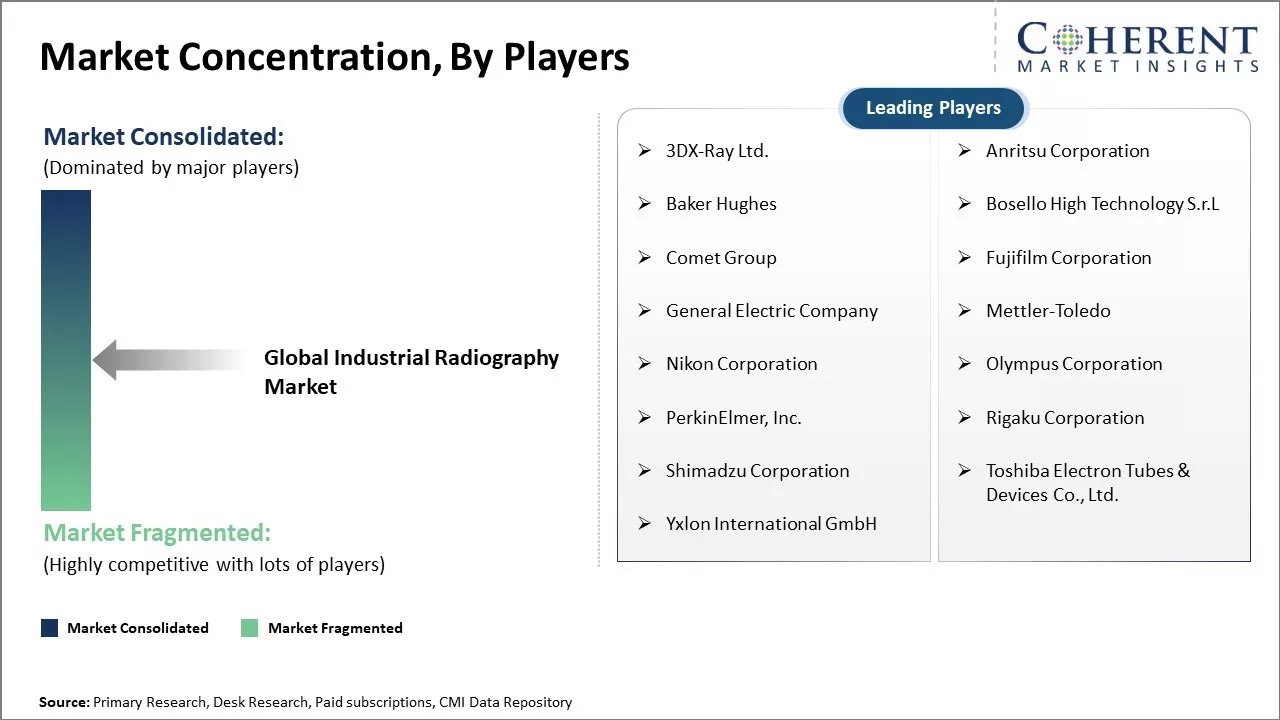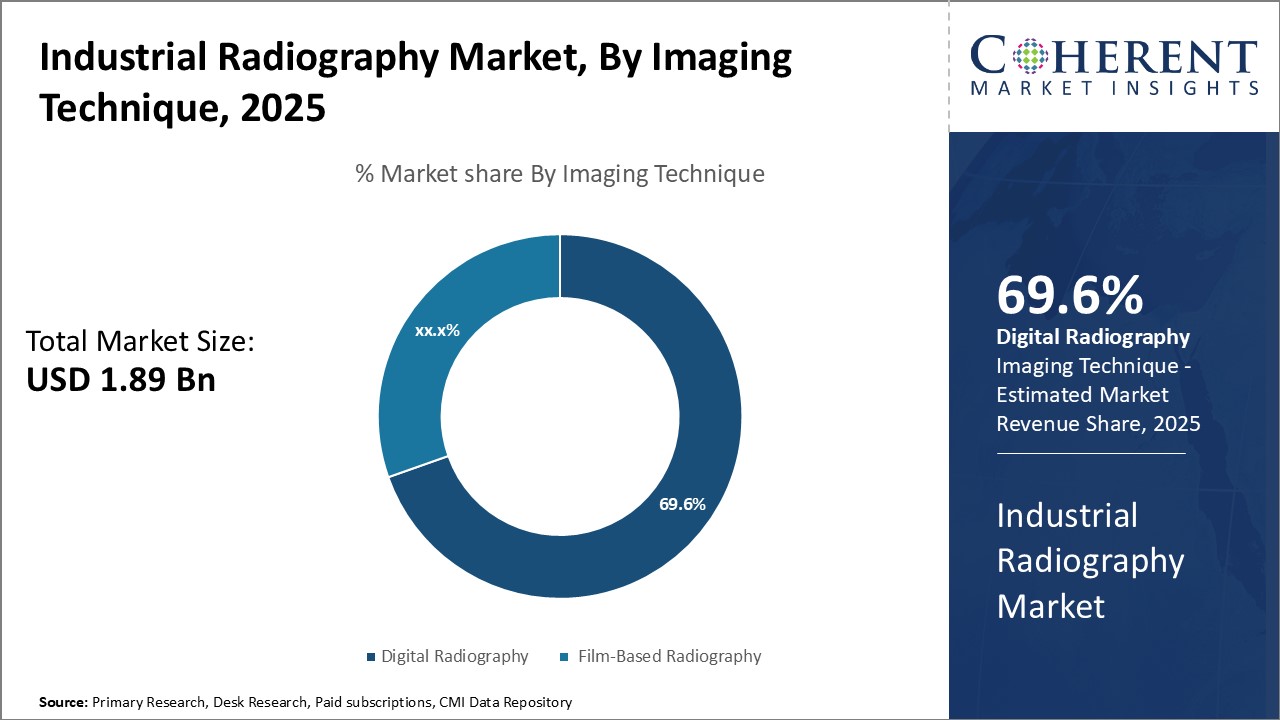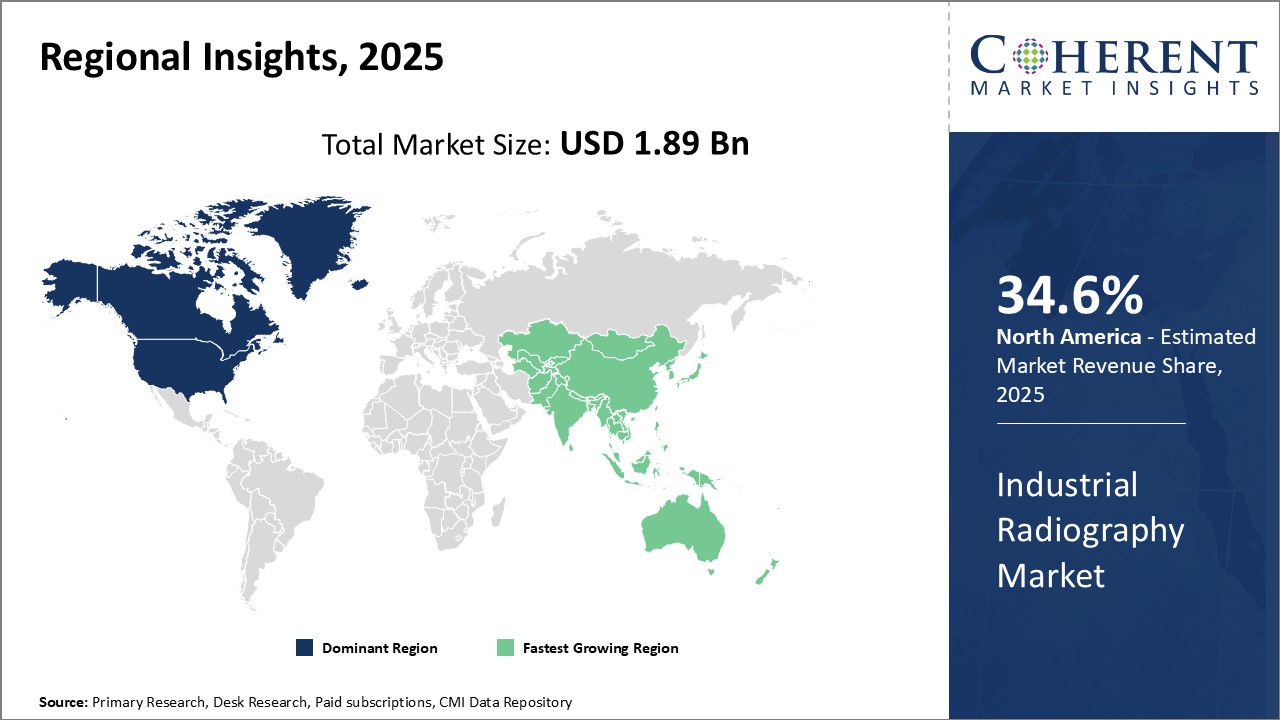Industrial Radiography Market Size and Trends
The global industrial radiography market is estimated to be valued at US$ 1.89 Bn in 2025 and is expected to reach US$ 3.45 Bn by 2032, exhibiting a compound annual growth rate (CAGR) of 9.0% from 2025 to 2032.

Discover market dynamics shaping the industry: Download Free Sample
There is an increasing demand for industrial radiography from various end-use industries like oil & gas, automotive, aerospace, manufacturing, and others. The growing oil & gas industry and need for pipeline inspection and monitoring are driving the growth of the industrial radiography market. Furthermore, adoption of digital radiography systems over traditional film-based systems due to their benefits like efficient workflow and reduced radiation exposure is supporting the market growth. However, the availability of alternative technologies for non-destructive testing and stringent safety regulations associated with radiography equipment can hamper the market growth during the forecast period. Nevertheless, increasing focus on pipeline integrity management programs worldwide is expected to provide opportunities for the industrial radiography market in coming years.
Rising adoption in oil and gas industry
The oil and gas industry has been one of the major adopters of industrial radiography techniques globally. With huge capital investments required to explore and extract oil and gas from newer fields located offshore or in difficult terrains, non-destructive testing to check integrity of pipelines and vessels becomes extremely important. Even during ongoing operations, periodic radiography tests are mandated to detect tiny cracks or defects that cannot be identified otherwise. This ensures safety and avoids accidents from technically failure of equipment. With increasing complexity of projects, authorities have strengthened regulations for infrastructure testing. At the same time, oil prices also rising pressure on companies to optimize output. Thus, industrial radiography emerges as reliable and cost-effective solution compared to dismantling equipment for physical inspection. Major oil producers have upscaled the usage of both film and digital radiography vans at all stages from designing to operational life. This growing reliance has also led to newer technologies focused on portability and high-resolution images for inspecting complex infrastructure. Overall, stringent norms and challenging projects have made industrial radiography indispensable practice in modern oil and gas sector worldwide.
Market Concentration and Competitive Landscape

Get actionable strategies to beat competition: Download Free Sample
Advancements in digital radiography systems
Constant innovation is taking place in the field of industrial radiography to develop more powerful yet flexible solutions. While film-based systems have been standard for long, digital variants now replace films with arrays of detectors coupled with hardware and software. This has opened up new application areas thanks to sharper images, faster processing and ability to enhance images on computer systems. Rather than physical darkrooms, digital files can be converted into videos, transmitted over networks and stored on cloud servers. Mobility has increased tremendously with portable wireless detectors and battery-powered X-ray sources. This enables on-site scanning of critical assets without moving heavy machinery. Beyond imaging, integrated AI and data analytics tools analyze defects visually identified by technicians. Some detectors can also perform basic measurements of welding joints, wall thicknesses, and other parameters from scans. Such analytical capabilities reduce reliance on human inspectors. Advanced robots deploy compact radiography systems for automated inspection in hard-to-reach areas. Going forward, the adoption of virtual reality and 3D modeling is expected to revolutionize how inspections are conducted and problems visualized. Undoubtedly, digital radiography presents itself as the future with higher quality, faster turnaround times and remote diagnostics.
Key Takeaways from Analyst:
The global industrial radiography market growth is driven by rising manufacturing activities across industries such as oil & gas, aerospace, automotive, and power generation. Industrial radiography finds widespread adoption for detecting flaws and cracks in welds, castings, and various metal components used in machinery, boilers, pressure vessels, and pipelines. Non-destructive testing techniques such as industrial radiography allow manufacturers to ensure product quality and safety.
North America currently dominates the global industrial radiography market owing to stringent regulations regarding safety inspection and presence of leading energy and manufacturing companies in the region. Meanwhile, Asia Pacific is expected to emerge as the fastest growing market with rapid industrialization in China, India, and other Southeast Asian countries. Restraints to market growth include risks associated with exposure to radiation and strict regulations regarding the use of radioactive materials.
Opportunities for market participants lie in the development of new radiography methods such as digital radiography that offer higher resolution and automation. Growing focus on upgrading aging infrastructure and adoption of robotic technology for inspections in hazardous locations will also fuel the demand. Additionally, the integration of artificial intelligence capabilities can make radiography testing more intuitive and enable automated defect recognition.
Market Challenge: Risk of radiation exposure
The global industrial radiography market is facing constraints in its growth trajectory primarily due to risks associated with radiation exposure. Industrial radiography uses highly penetrating electromagnetic or particulate radiation to examine the internal structure and operation of components and find surface breaking and subsurface defects in metals and alloys. However, prolonged or repeated exposure to radiation can lead to severe health issues in humans.
Market Opportunities: Adoption of digital radiography systems
The adoption of digital radiography systems is poised to provide significant opportunities for growth in the global industrial radiography market. Traditional film-based radiography, while having served industrial needs for decades, has disadvantages such as requiring darkroom setups for film processing. The move to digital allows for faster, high-resolution imaging that does not require film or chemicals to develop. Digital images can also be more easily shared, stored, and analyzed digitally. This provides efficiency benefits to end users in industries such as manufacturing, oil and gas, and construction where radiography is used for non-destructive testing.

Discover high revenue pocket segments and roadmap to it: Download Free Sample
Insights By Imaging Technique - Digital Radiography's Pivotal Role in Safety and Quality Assurance
In terms of imaging technique, the digital radiography segment is estimated to hold 69.6% share in 2025. Digital radiography has become the preferred technology for industrial non-destructive testing due to the significant business advantages it offers over traditional film-based methods. By eliminating the use of chemistry and film processing, digital radiography reduces costs and increases workflow efficiency. It provides immediate digital results that can be easily stored and transferred, supporting faster decision-making in industries.
Digital radiography also improves overall safety. By removing chemical handling from the procedure, it reduces the risks of personnel exposure to hazardous materials. Faster imaging cycle times and lower radiation doses, as fewer exposures are required to obtain the desired image quality, further enhance safety. Additionally, the digital images can be optimized on computers for better visibility of defects without the need for re-exposure, significantly improving personnel safety.
The image quality from digital radiography is highly consistent, as the process does not involve chemical baths and darkroom conditions. It provides sharper results even at lower radiation doses. This level of reproducibility supports stringent quality control and assurance requirements across industries such as manufacturing, power generation, and automotive. Digital formats also facilitate integration with advanced analysis software for automated inspection and defect detection.
In summary, the business benefits of digital radiography, including cost savings, workflow improvements, enhanced safety, and consistent high-quality imaging, have made it the preferred technology for industrial non-destructive testing across a wide range of industries.
Insights By End-use Industry - Strict Regulations in Petrochemical and Gas Sectors Drive Widespread Adoption of Digital Radiography
Among various end-use industries, the petrochemical and gas segment is estimated to account for 38.7% share in 2025. This is primarily due to the stringent safety and integrity testing regulations imposed on plants and pipelines in this sector. Even minor defects can lead to hazardous leaks and accidents in petrochemical and gas infrastructure.
Radiography has become a critical non-destructive testing (NDT) technique for the petrochemical and gas industries, where maintaining the operational integrity of process equipment and transport systems is of the utmost importance. These industries are subject to strict regulatory compliance, such as API 570 for pipeline testing, due to the hazardous nature of their products.
Regulators strictly enforce the use of radiography to inspect welds, vessels, and pipework for issues like cracking or wall thinning. This helps detect flaws immediately during the commissioning of new projects, as well as during routine monitoring of aging assets. The consequences of any failures in these critical systems make periodic NDT testing extremely crucial from a safety standpoint.
Radiography remains the gold standard for non-destructive inspections aimed at public safety and accident prevention in the petrochemical and gas sectors. Its ability to examine thick-walled and multi-layered structures with high material attenuation makes it an indispensable tool. Furthermore, the complex asset designs in these industries further support the greater reliance on radiography services to comply with legislation.
As a result, the petrochemical and gas industries have the highest radiography spending globally, driven by the regulatory pressure to ensure the operational integrity of their critical infrastructure and safeguard public safety.
Regional Insights

Need a Different Region or Segment? Download Free Sample
North America has dominated the global industrial radiography market with estimated market share of 34.6% share in 2025 owing to strong presence of many key players and robust end-use industries in the region. The U.S. is home to several leading players such as GE Healthcare, Fujifilm, Nikon Corporation, and Comet Group that have established their prominent research and manufacturing facilities. Also, major industries such as oil & gas, aerospace, automotive and manufacturing have been driving recurring demand for industrial radiography techniques. With growing infrastructure and ongoing revamping of aging assets, requirements for non-destructive testing continue to surge across sectors. However, advanced radiography technologies provide accurate evaluations in minimal time at lower operational costs.
The Asia Pacific region has emerged as the fastest expanding market for industrial radiography globally. Rapid industrialization and establishment of manufacturing hubs across China, India, Japan, and South East Asian countries are the prime factors propelling the growth. Stringent quality controls and safety regulations enforced by governing bodies have ensured higher uptake of radiography systems. Moreover, growing construction activities related to buildings, roads, pipelines and other civil projects create steady opportunities. Local presence of global industry leaders through joint ventures or acquisitions has augmented technology adoption. Additionally, favorable export-import policies and evolving foreign direct investments in end-use verticals are strengthening the regional position. Furthermore, cost advantages offered by emerging economies entice manufacturers to set up new production bases, thereby assisting market expansion.
The European market has also maintained decent growth on account of reviving economic conditions and presence of major oil producers. Countries like Germany, the U.K., France, Italy, and Russia exhibit noteworthy consumption owing to well-established oil & gas, automotive, aerospace and power industries Mandatory standards for asset integrity and material testing under various directives assure continued usage of radiography techniques. Additionally, the focus on renewable energy development and emphasis on integrating latest inspection methods to monitor aging infrastructure will positively influence the business scenario. Adoption of digital solutions further aids in improving efficiency while minimizing costs related to film and darkroom requirements.
Market Report Scope
Industrial Radiography Market Report Coverage
| Report Coverage | Details | ||
|---|---|---|---|
| Base Year: | 2024 | Market Size in 2025: | USD 1.89 Bn |
| Historical Data for: | 2020 To 2024 | Forecast Period: | 2025 To 2032 |
| Forecast Period 2025 to 2032 CAGR: | 9.0% | 2032 Value Projection: | USD 3.45 Bn |
| Geographies covered: |
|
||
| Segments covered: |
|
||
| Companies covered: |
3DX-Ray Ltd., Anritsu Corporation, Baker Hughes, Bosello High Technology S.r.L, Comet Group, Fujifilm Corporation, General Electric Company, Mettler-Toledo, Nikon Corporation, Olympus Corporation, PerkinElmer, Inc., Rigaku Corporation, Shimadzu Corporation, Toshiba Electron Tubes & Devices Co., Ltd., and Yxlon International GmbH |
||
| Growth Drivers: |
|
||
| Restraints & Challenges: |
|
||
Uncover macros and micros vetted on 75+ parameters: Get instant access to report
Industrial Radiography Industry News
- In January 2023, Blue Star, India's leading air conditioning brand, launched a comprehensive range of over 100 affordable yet premium split air conditioner models across the inverter, fixed-speed, and window AC categories. This new lineup caters to diverse consumer segments and price points, leveraging Blue Star's extensive R&D and manufacturing capabilities to deliver best-in-class features and performance.
- In February 2023, Carestream Health India announced the launch of DRX Compass, an accurate, convenient and configurable digital radiology solution designed to provide radiologists with a whole new level of efficiency. The DRX Compass offers versatility, allowing radiology facilities to build the desired configuration from a wide range of selections in detectors, tubes, generators, tables, and collimators, giving them full control over how they can use this future-proof digital radiology technology. With color-coded buttons, optional wall stand angulates, optional auto-centering and a common interface among all Carestream CR/DRX products, technicians can derive maximum value from DRX Compass without sacrificing time and energy in learning how to use the equipment.
- In March 2023, Fujifilm Medical Systems USA announced the launch of Fujifilm FCR Vixera G300D, a groundbreaking digital radiography system that produces high-quality images, enables rapid image capture, and improves workflow efficiency.
- In April 2022, GE Healthcare introduced Innova 660, an innovative digital radiography system designed to deliver enhanced image quality, improved workflow efficiency, and enhanced patient comfort. Innova 660 is a versatile system suitable for a wide range of applications, including general radiography, mammography, and computed radiography.
- In May 2022, Siemens Healthineers introduced the SOMATOM Force, an advanced dual-source computed tomography (CT) system that delivers high-quality images, rapid scanning speeds, and enhanced visualization capabilities. SOMATOM Force is designed for a wide range of clinical applications, including cardiac imaging, oncology, and neurology, enabling precise diagnosis and treatment planning.
*Definition: The global industrial radiography market consists of companies that provide radiographic testing services and equipment for non-destructive testing in various industries. These services help detect internal flaws or deficiencies in materials, components and assemblies without damaging them using x-rays or gamma rays. Common industrial applications include inspection of welds in structures like bridges, inspection of castings and forgings for defects in manufacturing plants, and inspecting pipelines and pressure vessels in oil and gas industries. The devices used are radiography cameras, flat panel detectors and line-scan cameras.
Market Segmentation
- Imaging Technique Insights (Revenue, US$ Bn, 2020 - 2032)
- Digital Radiography
- Film-Based Radiography
- End-use Industry Insights (Revenue, US$ Bn, 2020 - 2032)
- Power Generation
- Aerospace
- Petrochemical and Gas
- Manufacturing
- Automotive & Transportation
- Others
- Regional Insights (Revenue, US$ Bn, 2020 - 2032)
- North America
- U.S.
- Canada
- Latin America
- Brazil
- Argentina
- Mexico
- Rest of Latin America
- Europe
- Germany
- U.K.
- Spain
- France
- Italy
- Russia
- Rest of Europe
- Asia Pacific
- China
- India
- Japan
- Australia
- South Korea
- ASEAN
- Rest of Asia Pacific
- Middle East & Africa
- GCC Countries
- Israel
- South Africa
- Rest of Middle East & Africa
- North America
- Key Players Insights
- 3DX-Ray Ltd.
- Anritsu Corporation
- Baker Hughes
- Bosello High Technology S.r.L
- Comet Group
- Fujifilm Corporation
- General Electric Company
- Mettler-Toledo
- Nikon Corporation
- Olympus Corporation
- PerkinElmer, Inc.
- Rigaku Corporation
- Shimadzu Corporation
- Toshiba Electron Tubes & Devices Co., Ltd.
- Yxlon International GmbH
Share
Share
About Author
Ankur Rai is a Research Consultant with over 5 years of experience in handling consulting and syndicated reports across diverse sectors. He manages consulting and market research projects centered on go-to-market strategy, opportunity analysis, competitive landscape, and market size estimation and forecasting. He also advises clients on identifying and targeting absolute opportunities to penetrate untapped markets.
Missing comfort of reading report in your local language? Find your preferred language :
Transform your Strategy with Exclusive Trending Reports :
Frequently Asked Questions
EXISTING CLIENTELE
Joining thousands of companies around the world committed to making the Excellent Business Solutions.
View All Our Clients
